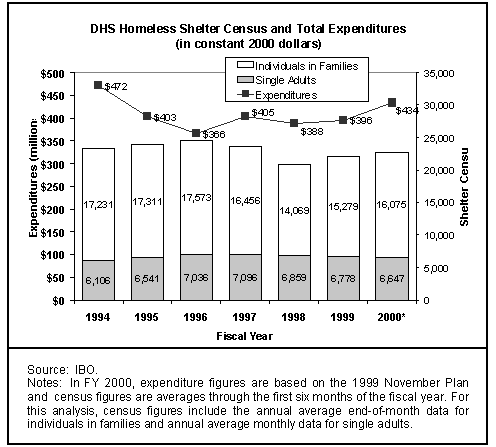In fiscal year 2000, total DHS expenditures are expected to reach nearly $434 million. Adjusted for inflation, this is an 8 percent decline from DHS's 1994 expenditures. However, it will mark the most DHS has spent since that year. Between 1994 and 1996 DHS spending, adjusted for inflation, fell 22 percent, but then increased 8 percent by 1999. Between 1999 and 2000, DHS spending is expected to increase by 10 percent or $38 million. The additional spending will include roughly 12 percent increases for contractors providing shelter services for homeless families ($15 million) and single adults ($13 million).

Over time, DHS moved responsibility for several single adult and family shelters from direct agency administration to not-for-profit contractors. This is reflected in a 39 percent decline in DHS full time employees, from 3,047 in 1994 to 1,856 in 1999. Fiscally, this resulted in a greater decline in inflation-adjusted spending for salaries than for other agency spending, which includes contracts. Between 1994 and 2000, spending for salaries (personal services) will have declined 18 percent, while all other spending (other than personal services) will have declined 5 percent.
A large portion of DHS spending is for shelter services, and the homeless shelter census has varied over time. In 1994, the total homeless shelter census averaged 23,337. It peaked in 1996 with a shelter census of 24,609. Due in part to the implementation of mandated eligibility investigations of family shelter applicants in late 1996, the census fell by 15 percent to 20,928 in 1998. While the eligibility investigations continued, the census increased to 22,057 in 1999 and continues to rise through the first six months of fiscal year 2000.
The DHS homeless shelter census includes two separate populations: families and single adults. The family shelter system comprises over two-thirds of the total shelter population. In 1994, the family census averaged 17,231. Like the total population, it peaked in 1996 at 17,573. With the mandated eligibility investigations, the census declined by 20 percent to14,069 in 1998, but then increased to 15,279 in 1999 and continues to rise.
The single adult shelter census exhibits smoother trends compared to the family census since it was not subject to the mandated eligibility investigations. The single adult census in 1994 averaged 6,106. It grew steadily through the next few years and peaked in 1997 at 7,096. Then it fell to 6,778 in 1999 and it continues to drop.
Since most DHS spending provides shelter services, it would seem logical to expect that DHS spending would rise or fall with increases or decreases in the homeless shelter census. But this was not the case in the early years when DHS spending reached its nadir in 1996 at the same time as the homeless shelter census peaked. However, in recent years, as the homeless shelter census has begun to climb again, DHS spending has inched upward and is expected to rise further in 2000. It is unclear whether the recent correlation between spending and the census is the beginning of a trend.
For more information about the NYC Department of Homeless Services contact Joshua Chang, a Budget and Policy Analyst at IBO, at (212) 442-8617.